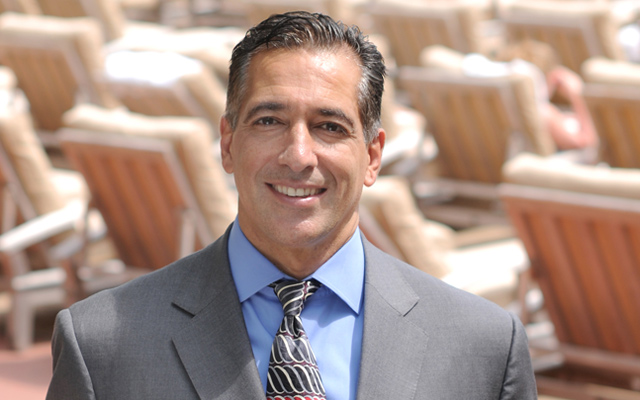“Awesome” has come to describe just about anything we like these days — so much so that it falls short when we recount moments of genuine awe. Standing before a great work of art, surviving a death-defying surfboard ride on a monstrous wave, or experiencing an unexpected encounter with something truly divine: These moments inspire a mixture of wonder and feeling overwhelmed, pushing us beyond the limits of our perception.
Feeling awed can be amazing, awful, or both, simultaneously. “Awe is the commingling of dread, veneration, and wonder,” says Kirk Schneider, PhD, author of Rediscovery of Awe and Awakening to Awe. And it moves us to understand our place in the universe — just how small, and how big, we really are. Schneider describes it as the “capacity to be deeply moved, and to experience the fuller ranges of being alive.”
These experiences can also inspire us to take action. Legendary naturalist John Muir was so moved by his encounters with the stands of giant sequoia trees and towering rock formations in Yosemite Valley, for instance, that he founded the Sierra Club, which has since preserved thousands of acres of awe-inspiring wilderness.
More recently, researchers who study positive emotions have found that awestruck moments can even inspire altruistic actions.
Awe, as it turns out, is not solely about the experience of being moved; it’s a feeling that also resides in our physical beings.
Your Body in Awe
“Our capacity for wonder and reverence is rooted in the body,” writes psychologist Dacher Keltner, PhD, in his book, Born to Be Good. We’ve all noticed the goose bumps (a.k.a. piloerection) on our arms during awe-inducing incidents; Keltner notes that people also report “an expansive, warm swelling in the chest” during these experiences. He believes this may be due to the activation of the vagus nerve, which is linked to the parasympathetic nervous system that helps calm us down.
Such incidents also trigger the left orbitofrontal cortex, the area of the brain associated with goal-directed behavior, Keltner explains. This area is activated when people reflect upon internal experiences from a broader perspective, an indication that your awestruck moment is helping you expand your viewpoint.
Additionally, research published in the journal Emotion in 2015 shows that experiencing awe may boost your physical health by lowering levels of inflammatory cytokines, proteins that affect cellular function.
For the study, college students filled out questionnaires about their experiences of specific emotional states; they were then tested to measure their cytokine levels. While joy, contentment, and pride all predicted a lowering of cytokines, feelings of awe corresponded to the greatest decrease and subsequent anti-inflammatory effect.
Beyond Happiness
Experiencing awe tends to disrupt our illusions of security and permanence. This can be unsettling — but also gratifying.
In his book Awe: The Delights and Dangers of Our Eleventh Emotion, Paul Pearsall, PhD, describes how he felt witnessing his mother take her last breath: a mixture of heartbreak, fear of his own mortality, and powerful gratitude for his mother’s love.
“Awe can help us go beyond the oversimplified idea that being happy and up is always good and is something for which we must strive, and being sad or down is always bad and something we should avoid at all costs,” Pearsall writes.
His account shows how, even in moments of discomfort, we can be astounded by the “vastness” of experience. In facing a loss, for example, we may find ourselves feeling profound gratitude for others, as we recognize on a deeper level how everyone’s time is limited. Working to accommodate this understanding, we start to transcend our habitual thinking.
Awe also keeps our egos in check, shifting our focus outward and toward connection — with our communities, nature, and the world.
Take, for instance, the 2007 study that found participants were more likely to describe themselves as feeling part of a universal group after viewing a life-size Tyrannosaurus-rex skeleton replica.
Or the research published in the Journal of Personality and Social Psychology in 2015 that showed that people behaved more altruistically after viewing a grove of some of the world’s largest eucalyptus trees for only 60 seconds.
Study coordinator Paul Piff, PhD, assistant professor of psychology at the University of California–Irvine, explains that participants were instructed to look up at either the towering trees or an adjacent building for one minute. Afterward, he and his team staged a minor accident: A researcher dropped a handful of pens on the floor. Participants who had gazed at the trees consistently offered more help to the pen-dropping researcher than those who’d looked at buildings.
“Just looking up at those trees,” Piff says, “made people more helpful and compassionate.”
Daily Inspiration
When we visualize awe-inspiring moments, we probably imagine standing before the Grand Canyon.
But Piff says his study participants often talked about awe as experiences of the everyday variety — such as the way a leaf gets caught up in the wind.
“We’re told that things like pride, entitlement, and self-esteem are what we value as humans, but our findings are suggesting that people also like losing themselves,” he explains. “People like experiencing things that allow them to embrace values like helping others.”
Being awestruck has as much to do with how we look at the world as it does with the world we’re looking at. When we’re jarred out of our usual ways of seeing — by the view through a telescope or studying the feathers of a bird — we find meaning in unexpected places. We become less fascinated by our own importance and more interested in our connection to other beings. We start to have more questions than answers.
And that can be a pretty awesome way to live.
5 Ways to Cultivate More Awe
Research has shown that feelings of awe benefit our physical and mental health and spark altruistic behavior. Here’s how to inspire more awe in your daily life:
1. Spend time in nature. Gazing at cloud formations or other natural wonders reminds us of our place in the vast universe.
2. Do some sort of meditative practice. It will help you become more attentive.
3. Cultivate solitude. You’ll notice your environment more, and have more room for self-reflection.
4. Visit museums and attend live performances. They are easy ways to be moved by something powerful.
5. Volunteer at places that serve others, such as hospice centers, animal shelters, or nursing homes. These places all remind us that life is a temporary gift.
Becoming Awed: A Q&A With Kirk Schneider, PhD
A leading expert shares his top ideas for cultivating more awe in your life.
Kirk J. Schneider, PhD, is a licensed psychologist and a leading spokesperson for contemporary existential-humanistic psychology. In 2004, he earned the Rollo May Award for “outstanding and independent pursuit of new frontiers in humanistic psychology” from the Society for Humanistic Psychology of the American Psychological Association.
He is the president of the Society for Humanistic Psychology of the American Psychology Association and vice-president of the Existential-Humanistic Institute (EHI). He is the author or coauthor of more than 10 books, including The Polarized Mind and The Paradoxical Self. His books, Awakening to Awe and Rediscovery of Awe, outline how reviving and exploring our sense of awe would positively affect psychology, politics, education, culture, and our daily lives.
When he’s not busy writing or speaking, Schneider teaches at Saybrook University and Teachers College, Columbia University.
Experience Life | What defines awe?
Kirk Schneider | It is technically defined as the commingling of dread, veneration, and wonder. But I summarize it as the humility and wonder or sense of adventure toward living. Awe is also the capacity to be deeply moved and to experience the fuller ranges of being alive. For me, these many and contrasting dimensions make awe a supreme concept of transcendental experience, which too often gets reduced to one-dimensional terms like blessedness and bliss, but full living in my view has daunting as well as exalting qualities. The trick is to feel free enough to experience the intensity and poignancy of both.
EL | What’s challenging and difficult about awe? Might we shy away from awe-inducing experiences, consciously or unconsciously?
KS | Awe is challenging because it shifts us outside the box of the routine and familiar, and that’s always a bit jarring — as much as it can also be quite exhilarating and liberating. Certainly there is an awe phobia that goes along with awe depletion in our society because our socioeconomic system stands in almost direct contrast to awe cultivation.
As long as we continue to prize the quick fix, the efficiency and machine model for living — speed, instant results, and appearance and packaging — we’re going to remain awe resistant and awe avoidant because slowing down, pausing, appreciating the paradoxes of living — such as our fragility, boldness, vulnerability, and a profound appreciation for life — don’t often go along with a “maximize profits” world. So yes, I think we shy away from the sense of awe both consciously and unwittingly to the degree we fail to question or reform our awe-sapping ways of life.
EL | In what ways, precisely, does a sense of awe (or an awe-based consciousness) have a positive impact on us personally? What traits does it foster? How does it affect our lives positively (transformatively) if we look at things as “awesome” and negatively if we look at them as “awe-ful”?
KS | There is a trend these days to reduce awe, like so many other energizing emotions, to changes in biological markers, such enhancements of the immune system or to specific states of well-being.
These are important and helpful studies so far as they go, but they tend to imply that the acquisition of awe is like the acquisition of a drug to achieve a desired targeted effect. In some sense it turns awe into a commodity that can achieve specific health-producing effects, which I believe it can, and that is very important to know, particularly because it has been such an understudied and underappreciated phenomenon.
But in my view, awe is much more than a “tool” that can be drawn upon for a desired effect; it’s a way of being, an attitude toward moment-to-moment living — to the degree possible — that is a result of a life deeply lived.
I don’t want to give people the impression that awe is yet another quick fix that can be “used” when handy or necessary while the rest of its implications, for example, for a whole new way of living, a reformed society — at the level of childrearing, education, ecology, religion and spirituality, and even legislative and diplomatic deliberation — are completely overlooked. Awe is the basis for a new moral and ethical identity in the development of human organization and consciousness, and that is its most important legacy. It could well help to save the human species.
EL | Are there any unexpected areas where it can have an impact?
KS | I already mentioned childrearing, the educational setting, the work setting, the environmental setting, the religious and spiritual settings, and the political-deliberative settings. These may all be surprising areas of transformation through awe-based practices. Moreover, I think the cultivation of the sense of awe and the bigger picture of living (that does not “end” in dogma but in discovery) is integral to addressing depression and many other psycho-spiritual disturbances that are basically about overidentification with narrow and self-devaluing aspects of ourselves and life. Real-life examples of the healing power of awe are the resilient lives of Stephen Hawking, despite horrible debilitating illness, and Viktor Frankl, who survived Nazi death camps.
EL | What, if anything, interferes with our sense of awe or experiencing awe? Being overbusy, glued to technology, and lack of time in nature?
KS | The polarized mind or “fixation on one point of view to the utter exclusion of competing points of view” interferes with cultivating awe. The polarized mind is not confined to what we typically call mental disorders or to certain disenfranchised people. It’s a worldwide, cross-cultural, and cross-historical scourge that has caused great human destructiveness. The polarized mind is basically predicated on the fear or panic that one is insignificant, helpless, and ultimately invisible as a being, and is usually the result of being brutalized by others who have felt the same way, and on and on the cycle of war and hatred goes. There have only been a few bright lights in history who have avoided this fate, and they are usually marginalized in their societies, more spiritual or mystical than dogmatically religious or ideological, and more holistic (present, mindful) in their approach to themselves and others.
EL| Does attempting to capture a wondrous experience by photographing or Tweeting about it interfere with the wonder of it?
KS| Most anything that aspires to the quick fix and absolute answer interferes with awe cultivation. On the other hand, almost anything that’s approached with maximal presence or whole-body awareness tends to be more conducive to awe.
Technology certainly presents a new danger of polarization because as long as the machine is the mediator of human awareness and much of living, we will become more like machines, and our sense of dignity, personal agency, and capacity for intimacy are likely to wither. On the other hand, I do believe machines can be used for awe-based purposes, and this is one of our great challenges as we move into a radically mechanized era.
EL | How do we create or tap into an awe-based consciousness, and how can we cultivate more awe in our everyday lives?
KS | This is where the “rubber hits the road.” I go into this in-depth in my books, but suffice it to say that it often takes a life-shaking awareness — sometimes trauma — to help us break through the routine fabric of living and to experience a much larger sense of being alive. Basically it involves connection with the bigger picture of living, and a sense of participation in that big picture as well as humility about how much it exceeds our grasp. Certainly, depth psychotherapy, meditation, and profound mentorship can inspire an awe-based consciousness.
First and foremost, a life deeply lived usually derives from caretakers, whether a parent or mentor who is able to model life that is relatively internally free — to discover, create, feel depths as well as heights of life, and identify with the “more” of who one is. This means a mentor who is in touch with the bigger picture of life and who experiences the thrill as well as anxiety of participating in something much greater than oneself that can continually put narrow and petty identifications in perspective and find joy in evolving, deepening.
Experiencing the depths of awe also requires participating in activities that allow the acknowledgment of the passing nature of time and life and therefore the preciousness of time and life. It takes a capacity for wonder and surprise, acknowledgment that each moment is a part of a vast context of possibility and discovery, appreciation for the subtleties and intricacies of life as experienced by fuller presence, pausing to reflect or fully savor the many shades and flavors of the moment.
It also takes an attunement to one’s emotions and body sensations and the capacity for cultivating solitude and befriending one’s self — which means learning to spend some quality time alone or just being.
This article originally appeared as “Awestruck” in the December 2015 issue of Experience Life.




This Post Has 0 Comments